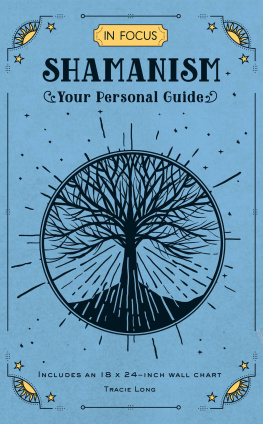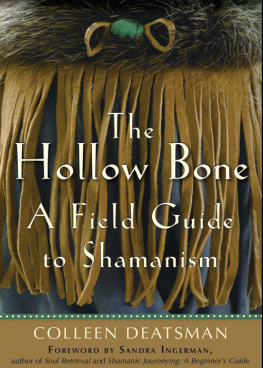Contents
Page List
Guide
Cover
CONTENTS
T he word shaman in general terms means one who sees or one who knows, and its thought to have originated from the Tungus people of Siberia, who call such people amn. Shamans are highly respected people within their communities or tribes because they provide wisdom, healing, rite-of-passage ceremonies, counseling, and knowledge. They tend to either come from a lineage of shamans or be chosen by spirit; it can take many years of teaching to become a shaman and to learn how to work with the land and with elements and nature. Shamans believe that everything has a spirit and that everything is connected. They also use altered states of consciousness to call upon spirit guides, ancestors, animal totems, and guardians while they seek to bring back harmony and balance to the land, the tribe, or an individual person.
Shamans see illness as loss of power, which they work to return to their patientsespecially when it has been lost during their lives through loss or trauma, although in some cases, the loss of power can link back to past-life issues. The shaman will remove unwanted energy or unneeded blockages from the body, a process called shamanic extraction. The energy may not be inherently bad but rather misplaced, and because it is not meant to be in the body, it shows up as pain, illness, or emotional problems.
Shamans work with the spirit or the soul of a person so their healing takes place at soul level. They obtain their knowledge by working with their spiritual guides, which include animal guides, through shifting their state of awareness, and in some cases they connect to those whom they are healing through journeying, drumming, and medicines, or by seeing the patient through the eyes of their guides.
A Tungus shaman
Sometimes the shaman may perform a soul retrieval. Soul loss can happen after a traumatic experience, such as an accident, during which part of the soul leaves the body in order to protect itself. Unfortunately, the lost part of the soul doesnt always return, so the person may live on for a long time feeling that part of them is missing.
Shamans can look into past lives. They put their patient into a meditative state and then take them back to a time when the patient experienced something that may now be contributing to a mental or physical health problem. When the patient journeys along with the shaman, they are able to pinpoint the issue and to make sense of it. Often, knowing the cause helps the patient to take back their power and start healing themselves because they now understand where the issue stems from.
What Is Shamanism?
Shamanism is a form of spirituality that seeks to expand ones consciousness. While many people associate it with North and South America, it has been practiced all over the world, including in Asia, Africa, Europe, and Australasia. Shamanism still flourishes today in the Andes and the Amazon, and traditional healers abound in southern Africa. They have different names in different cultures, but whatever they are called, their methods are strikingly similar all over the world.
Shamans are commonly known to be healers and spiritual guiders. Through history, they were healers at first, then teachers, visionaries, and mystics. Each shaman is different and each works in their own unique way. There are shamans who care for the earth and nature and weather shamans who work to bring rain or warmth when it is needed. There are those who help to heal the sick and others who assist the dead on their journey back to the spirit world.
Shamans serve as intermediaries between this world and others and for the connections between all living things. It takes them many years to develop their spiritual sight and learn to find answers in the invisible world that connects us. When trained, they can draw upon the relationships that they have formed with their guides and traverse realms, acquiring the knowledge, information, and assistance needed for rituals and ceremonies. They can decipher symbols and understand what they represent or use them as tools of empowerment. A symbol may be interpreted many ways, but each shaman has their own method of interpretation.
Shamans can put themselves into a trancelike state that enables them to move between states of consciousness at will, and they do this by singing, dancing, meditating, and drumming. Animals often play an important role, acting as omens and message bearers as well as representations of the animal spirit guides. While the shaman is performing a ceremony, their spirit leaves their body and enters the spiritual realms, enabling them to perform certain tasks.
Interest in shamanism has grown in recent years, and the subject attracts many spiritual seekers. There are shamanic schools and foundations that teach courses and hold workshops, and it has even become part of the tourist industry, with teachers and practitioners taking groups to destinations in the Andes and the Amazon to work with established shamans. Some shamans are happy to open their doors to teach those outside their culture how to expand knowledge of their spiritual path, in addition to holding ceremonies and performing rituals. Their courses often include learning about healing and medicine techniques.
But you dont have to book a trip or go on a spiritual quest to learn the basic techniques; they are easy to learn, and you just need a little self-discipline and dedication. You may start by teaching yourself from a book, but if you want to develop your skills, you will need to find a real shaman who can give you instruction.
Altered States of Consciousness
Altered states of perception can be measured with electroencephalography (EEG), which shows us the number of brain-wave cycles, or rhythmic pulses of neural activity, the brain produces every second. The normal oscillation of a beta wave in an adult is between thirteen and thirty-eight cycles per second, and the alpha wave oscillation is about eight to twelve cycles per second when a person is relaxed or meditating. This is being in the here and now. Theta waves oscillate at four to seven cycles per second, and they become dominant just before we fall asleep, during lucid dreaming, or when we reach a deep trance state during meditation or journeying. Delta waves oscillate at less than four cycles per second when we are asleep.
We can all learn to alter our state of consciousness by practicing meditation, but some may want to take it further so they can have out-of-body experiences or try lucid dreaming. Lucid dreaming is when one chooses something to dream about, falls into a kind of daydream or trance state, then falls asleep and continues with the chosen dream on occasion.
Other Roles in Shamanism
A shaman may be called upon to heal someone who feels lost or depressed and can help to restore the patient back to health because shamanic practice works for mental health as well as physical health. The shaman may journey, or conduct a ceremony for this, because they will need to be in an altered state in order to form a diagnosis and to restore the persons power and bring the patient back to a state of harmony.













